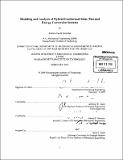| dc.contributor.advisor | Jefferson W. Tester. | en_US |
| dc.contributor.author | Greenhut, Andrew David | en_US |
| dc.contributor.other | Massachusetts Institute of Technology. Dept. of Mechanical Engineering. | en_US |
| dc.date.accessioned | 2010-09-01T16:28:47Z | |
| dc.date.available | 2010-09-01T16:28:47Z | |
| dc.date.copyright | 2009 | en_US |
| dc.date.issued | 2010 | en_US |
| dc.identifier.uri | http://hdl.handle.net/1721.1/58087 | |
| dc.description | Thesis (S.M.)--Massachusetts Institute of Technology, Dept. of Mechanical Engineering, February 2010. | en_US |
| dc.description | Cataloged from PDF version of thesis. | en_US |
| dc.description | Includes bibliographical references (p. 116-118). | en_US |
| dc.description.abstract | Innovative solar-geothermal hybrid energy conversion systems were developed for low enthalpy geothermal resources augmented with solar energy. The goal is to find cost-effective hybrid power cycles that take advantage of the potential synergies of solar thermal and geothermal resources. One aspect is to determine the hybrid configuration that yields the highest annualized electricity generation. The levelized cost of electricity (LCOE) is estimated using equipment costing rules of thumb developed from Aspen HTFS and Aspen ICARUS software and from other sources. Detailed models for the hybrid solar-geothermal system were developed using Aspen Plus and Aspen Dynamics. Turbine flexibility relative to vapor flow rate, temperature and pressure variations was analyzed. In one scenario, a parametric steady-state study was carried out to examine the performance over the range of conditions resulting from diurnal and seasonal variations. The results of the diurnal and seasonal parametric studies were grossly weighted to approximate a typical year in Nevada, and these results led to an estimate of the annualized electricity generation. In another scenario, a dynamic model was selected from possible "greenfield" hybrid systems and used to examine the transient performance for a typical January day and a typical July day in Nevada. The dynamic model approximates the thermal inertial of the heat exchangers and the working fluids in the exchangers, solar collectors, piping and storage tanks. The dynamic model is driven with forcing functions for solar input and ambient temperature to approximate the typical winter and summer days. | en_US |
| dc.description.abstract | (cont.) In all cases, solar energy was found to come at a higher cost per kW capacity than geothermal when the cost of geothermal wells was not considered. However, including well costs had an effect of evening out the levelized cost of electricity. Model complexity increased as more solar heat was added to existing geothermal systems, which suggests that moving a higher exergy heat source down to a lower exergy heat source is difficult, especially given the transient nature of the solar resource. The models developed in this thesis demonstrate the design decisions and complex dynamic behavior inherent in this type of hybrid system. | en_US |
| dc.description.statementofresponsibility | by Andrew David Greenhut. | en_US |
| dc.format.extent | 173 p. | en_US |
| dc.language.iso | eng | en_US |
| dc.publisher | Massachusetts Institute of Technology | en_US |
| dc.rights | M.I.T. theses are protected by
copyright. They may be viewed from this source for any purpose, but
reproduction or distribution in any format is prohibited without written
permission. See provided URL for inquiries about permission. | en_US |
| dc.rights.uri | http://dspace.mit.edu/handle/1721.1/7582 | en_US |
| dc.subject | Mechanical Engineering. | en_US |
| dc.title | Modeling and analysis of hybrid geothermal-solar thermal energy conversion systems | en_US |
| dc.type | Thesis | en_US |
| dc.description.degree | S.M. | en_US |
| dc.contributor.department | Massachusetts Institute of Technology. Department of Mechanical Engineering | |
| dc.identifier.oclc | 650341555 | en_US |
